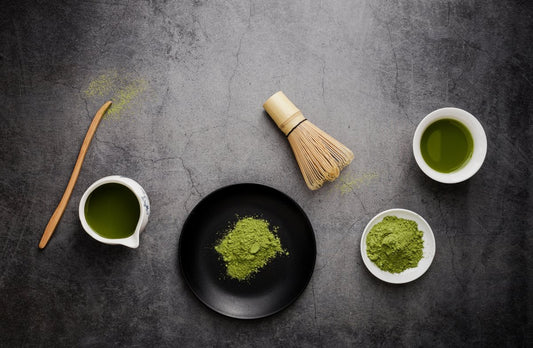Japanese Green Tea (Thé Vert Japonais): Tradition, Flavor & Wellness
Japanese green tea (thé vert japonais) is renowned for its delicate flavors, rich history, and powerful health benefits (bienfaits pour la santé). From ceremonial matcha (matcha cérémonial) to sencha, gyokuro, and genmaicha, Japan produces some of the finest green teas (meilleurs thés verts) in the world.
In this guide, we’ll explore the different types of Japanese green tea (types de thé vert japonais), their benefits (bienfaits du thé vert), and how to prepare them (comment préparer le thé vert japonais) for the best experience.
What Is Japanese Green Tea? (Qu’est-ce que le Thé Vert Japonais ?)
Japanese green tea is made from the Camellia sinensis plant (plante Camellia sinensis), but what makes it unique is its steaming process (procédé de cuisson à la vapeur). Unlike Chinese green tea, which is pan-fired, Japanese green tea is steamed to prevent oxidation (cuit à la vapeur pour éviter l’oxydation). This gives it a vibrant green color (couleur verte éclatante) and a fresh, grassy flavor (saveur fraîche et herbacée).
Most Japanese teas are also shade-grown (cultivés à l’ombre), which enhances chlorophyll (chlorophylle), amino acids (acides aminés), and antioxidants (antioxydants puissants).
Types of Japanese Green Tea (Types de Thé Vert Japonais)
Japan produces a variety of green teas, each with its own unique flavor (saveur unique) and nutritional profile (profil nutritionnel):
1. Matcha (Thé Vert Matcha)
- Powdered green tea (thé vert en poudre) used in Japanese tea ceremonies (cérémonies du thé japonaises).
- High in L-theanine (L-théanine) for calm energy (énergie apaisante) and focus.
- Try our premium Kato Matcha Organic Spring Harvest for a smooth, umami-rich matcha experience.
2. Sencha (Thé Vert Sencha)
- The most popular steeped green tea (thé vert infusé) in Japan.
- Rich in vitamin C, catechins, and caffeine (caféine naturelle).
- Offers a fresh, slightly astringent taste (goût frais et légèrement astringent).
3. Gyokuro (Thé Vert Gyokuro)
- A luxury shade-grown green tea (thé d’ombre de luxe) with a high L-theanine content (teneur élevée en L-théanine).
- Sweeter and more umami-rich (plus sucré et umami) than sencha.
- Higher in caffeine (caféine naturelle) for long-lasting energy.
4. Genmaicha (Thé Vert Genmaicha)
- A blend of sencha and roasted brown rice (riz brun grillé).
- Offers a nutty, toasty flavor (goût noisette et grillé).
- Lower in caffeine (moins de caféine), making it a great afternoon tea (thé de l’après-midi).
5. Hojicha (Thé Vert Hojicha)
- A roasted green tea (thé vert torréfié) with a warm, caramelized flavor (saveur caramélisée et douce).
- Low in caffeine (faible en caféine) and easy to digest.
- Perfect for evening relaxation (relaxation du soir).
Health Benefits of Japanese Green Tea (Bienfaits du Thé Vert Japonais)
Japanese green tea is known for its many health benefits (nombreux bienfaits pour la santé), including:
1. High in Antioxidants (Riche en Antioxydants)
- Contains catechins (catéchines) and EGCG (épigallocatéchine gallate), which help:
✔ Fight free radicals (lutter contre les radicaux libres)
✔ Support the immune system (renforcer le système immunitaire)
✔ Promote youthful skin (favoriser une peau éclatante)
2. Provides Natural Energy (Énergie Naturelle et Durable)
- Contains natural caffeine (caféine naturelle) for an energy boost (booster d’énergie naturel).
- High L-theanine (L-théanine) content helps reduce stress (réduction du stress) and increase mental focus (concentration mentale).
3. Supports Metabolism & Weight Loss (Stimule le Métabolisme et la Perte de Poids)
- Boosts fat oxidation (augmente l’oxydation des graisses) and helps regulate blood sugar levels (taux de sucre dans le sang).
- Sencha and matcha are great choices for weight management (gestion du poids).
How to Prepare Japanese Green Tea (Comment Préparer le Thé Vert Japonais ?)
To get the best flavor (meilleure saveur) and health benefits, follow these steps:
✔ Use High-Quality Tea (Utiliser un Thé de Qualité) – Try Kato Matcha Organic Spring Harvest for the finest Japanese matcha.
✔ Mind the Water Temperature (Surveiller la Température de l’Eau) – Japanese green teas should be brewed at 175°F (80°C) to preserve delicate flavors (préserver les saveurs délicates).
✔ Adjust Steeping Time (Adapter le Temps d’Infusion) – Steep for 30 seconds to 2 minutes (30 secondes à 2 minutes) depending on the tea type.
✔ Whisk for Matcha (Fouetter pour le Matcha) – Use a bamboo whisk (fouet en bambou) for a smooth, frothy matcha experience.
For an authentic matcha preparation, explore our Matcha Essentials Bundle.
Why Choose Japanese Green Tea? (Pourquoi Choisir le Thé Vert Japonais ?)
If you love high-quality green tea (thé vert de haute qualité) with delicate flavors (saveurs délicates) and rich health benefits (bienfaits pour la santé), Japanese green tea is the perfect choice.
✔ Higher in antioxidants (plus riche en antioxydants) than many other teas
✔ Sustainable farming practices (pratiques agricoles durables)
✔ Unique umami flavor (goût umami unique)
✔ A part of Japanese tradition (héritage du Japon)
Discover the Best Japanese Green Tea Today! (Découvrez le Meilleur Thé Vert Japonais Aujourd’hui !)
Experience the true taste of Japanese green tea (véritable saveur du thé vert japonais) with Kato Matcha Organic Spring Harvest—sourced from Uji, Kyoto for the finest quality. Or explore our Matcha Essentials Bundle for a complete matcha-making experience! 🍵✨


